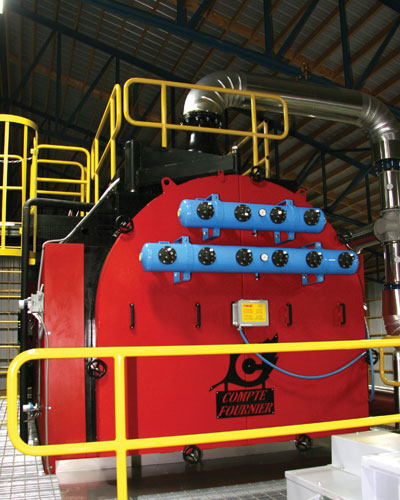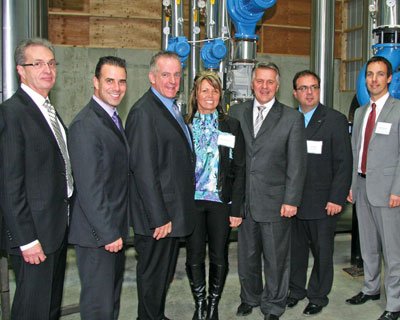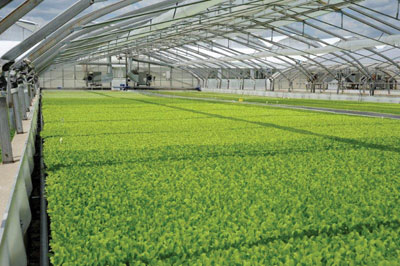
From Propane to Wood Residues
February 16, 2012
By Martine Frigon
Many projects that involve a biomass heating system have been realized in Québec during the past few years
Many projects that involve a biomass heating system have been realized in Québec during the past few years: a hospital, such as the one located in Amqui, a school in Kamouraska, in the eastern part of the province, and even greenhouses, as is the case for Les Serres Lefort.
 |
|
| The biomass heating system chosen by Lefort counts two boilers that weigh 100 tons each, an open buffer tank with a 1.3-million-litre capacity and a hot water distribution system to heat the company’s 6.5 hectares of greenhouses.
|
Located in Ste-Clothilde de Châteauguay on the southern shore of Montreal, only 25 kilometres from the New York border, Sylvain Lefort and his wife Marie-Josée Lebire run a business specializing in the production of transplants. Operating 140 greenhouses on 6.5 hectares, the couple chose to move to biomass for their heating needs, and the conversion was not a small project.
The gigantic biomass system was up and running in October 2011, an investment totalling $7.8 million. Faced with the increase of fossil fuel energy costs, the Leforts decided to look beyond propane, the heating system they had already in place.
“In greenhouse production, energy cost is one of the major factors we have to take into account”, said Sylvain Lefort. “In 2008, we started to look for alternatives and decided to move forward with forestry biomass.”
Many players were involved in the decision-making process, among them, Jean Gobeil, forest engineer and consultant in biomass heating systems. Having participated in two other similar conversions to a biomass system in the province, this retired professor from Université Laval is recognized as an expert in this field. “I have visited installations in France where a biomass system is used, and I must say that we are just at the beginning; we have a lot to do yet in Québec in terms of conversion for renewable energy,” said Gobeil.
For the Leforts, Gobeil undertook a feasibility study. The project received a financial contribution of $5 million from the Bureau de l’efficacité et de l’innovation énergétique from the Québec Ministry of Natural Resources, to be used toward programs targeting the reduction of heavy oil consumption. Gobeil was also mandated to give his advice on the choice of manufacturer.
“For this project, we had six suppliers on the shortlist, and the technology developed by Compte-Fournier made up our minds,” he said. Construction began on the Leforts’ biomass heating system in March 2011.
Compte-Fournier is an association of two manufacturers: GroupeCompte-R, located in France, that has installed more than 1,500 medium- to high-power biomass plants throughout the world, and Industries Fournier, in Thetford Mines, Québec.
“Our boilers are used in hospitals, district heating networks, industries, greenhouses and even the London 2012 Olympic Games,” said Harold Roy, president of CompteFournier. “We are proud to have installed a system built here in Québec with technology from Europe.”
TWO Big BOILERS
The biomass heating system chosen by Lefort has two boilers that weigh 100 tons each, an open buffer tank of 1.3 million litres and a hot water distribution system to heat its greenhouses, with thermal shields on the broad-span greenhouses.

|
|
| From left to right: Jean Gobeil; Stéphane Billette; Sylvain Lefort and Marie-Josée Lebire, owners of Les Serres Lefort; Laurent Lessard; Harold Roy, president of CompteFournier; and Dominic Compte, president of GroupCompte-R in France.
|
Measuring 24 by 32 metres, the boilers have a thermal power capacity of 12 megawatts (40 million BTU/h). Outside the building, a hot water storage tank called a hydro-accumulation boiler, made by Star Brite Manufacturing, can contain up to 1.3 million litres. Temperature and water level sensors, two diffusers and a corrosion inhibitor complete the stratification.
About 400,000 litres of hot water circulate into two kilometres of pipe installed in the greenhouses. In order to meet the needs of production, the climate management of the whole installation is managed using a computer program made by Priva.
“This biomass system will help reduce greenhouse gas emissions by up to 12,757 tons per year, compared to propane,” said Roy.
“We used up to 8 millions of litres of propane per year,” added Lefort. “We estimate that we will save 50% on our energy costs the first year, and get payback in three.”
The biomass is supplied by Bois Énergie3G, located in Sherbrooke, Québec, and stocked in a warehouse. Supplemented with hemlock residues, the biomass is brought to the boilers by four hydraulic valve lifter pullers. “These wood residues have a humidity level of 35%, and the system will need five truckloads per day on average, which means 17 to 18 tons annually,” said Gobeil.
According to the manufacturer, the boilers can heat wood residues to a humidity level between 15 and 60%.
“Everything is in the combustion control,” he added.
PRODUCING FOR 250 FARMERS
One of the only businesses that produce grafted plants in Canada, Les Serres Lefort provides transplants of broccolis, cauliflowers, tomatoes and celeries, among others, for 250 truck-farmer producers. This equates to nearly 65%of all produce offered in the Québec market.
 |
|
| Les Serres Lefort provides transplants of broccolis, cauliflowers, tomatoes and celeries, among others, for 250 truck-farmer producers – that means nearly 65% of the produce offered in the Québec market.
|
During the last few years, the couple developed some new products, such as seedlings of vegetables, square soil blocks and hydroponic lettuce that lead to the production of seven million heads of Boston lettuce per year.
Les Serres Lefort is in operation almost 12 months a year and counts about 50 employees, including an agronomist and a team of technicians. The Leforts can also depend on foreign employees during the peak season.
Since Sylvain Lefort started with two greenhouses in his backyard in 1981, things have really changed. But with daughter Julie in on the business, Les Serres Lefort will not.
Print this page